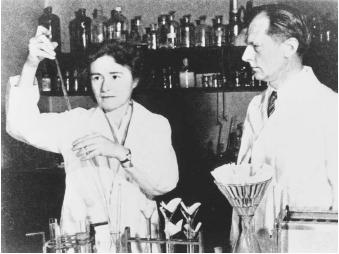glycogen

Figure 1. Glycogen molecules.

Figure 2. Carl and Gerty Cori. Photo credit: Jeff Miller, Oregon State University.
Glycogen is the chief carbohydrate used to store energy in animals (its counterpart in plants is starch). It is a polysaccharide consisting of a long, highly-branched chain of up to 100,000 glucose molecules (Figure 1).
Glycogen is particularly abundant in the liver and to a lesser extent in muscle. It can be broken down into glucose with glucagon, while insulin converts glucose to glycogen (a process called glycogenesis). In the electron microscope, glycogen has a characteristic asterisk or star appearance.
Cori, Carl Ferdinand (1896–1984)
Carl Cori was a Czech-born American biochemist who shared the 1947 Nobel Prize in Physiology or Medicine with his wife, Gerty Theresa Radnitz Cori (1896–1957), for their joint elucidation of the processes by which glycogen is broken down and reformed in the body (Figure 2). (B. A. Houssay also shared in 1947 Nobel Prize.)


